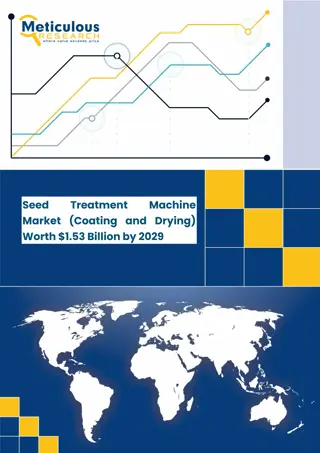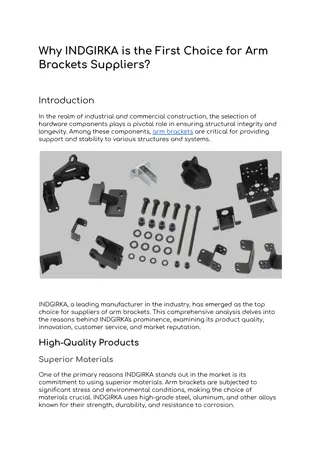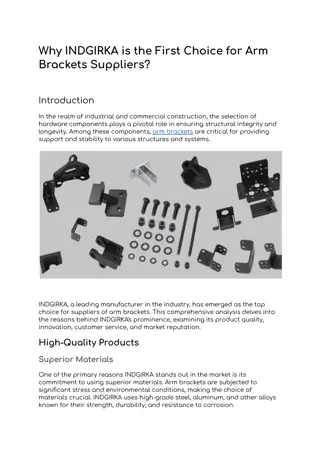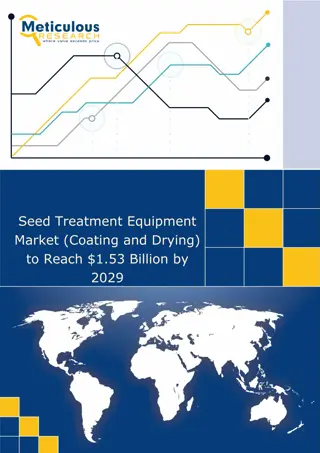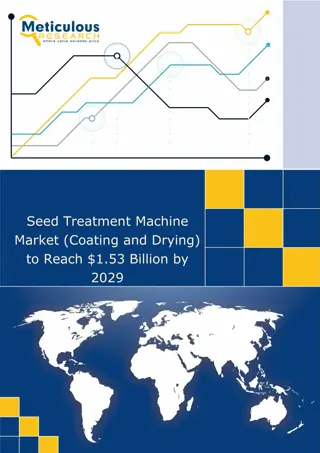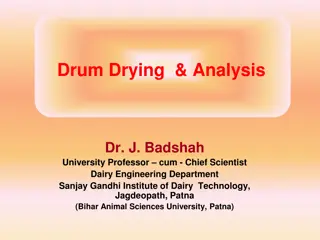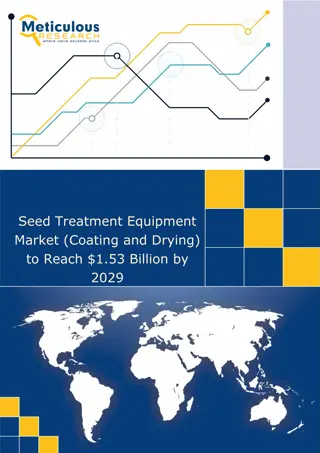Brief History of Drum Industry Highlights
The Drum industry has a rich history dating back to 100 AD when oil drums were first used, evolving through wooden barrels, steel drums, to modern advancements like performance packaging rules and reconditioning regulations. Explore the key milestones and achievements in the development of drums as essential containers for various industries.
Download Presentation

Please find below an Image/Link to download the presentation.
The content on the website is provided AS IS for your information and personal use only. It may not be sold, licensed, or shared on other websites without obtaining consent from the author.If you encounter any issues during the download, it is possible that the publisher has removed the file from their server.
You are allowed to download the files provided on this website for personal or commercial use, subject to the condition that they are used lawfully. All files are the property of their respective owners.
The content on the website is provided AS IS for your information and personal use only. It may not be sold, licensed, or shared on other websites without obtaining consent from the author.
E N D
Presentation Transcript
Thinking about Eduqas GCSE Design & Technology An introduction for New Centres
Assessment Objectives AO1 (10%) EXAM Identify, investigate and outline design possibilities to address needs and wants AO2 (30%) NEA Design and make prototypes that are fit for purpose AO3 (20%) EXAM (10%) + NEA (10%) Analyse and evaluate: design decision and outcomes including for prototypes made by themselves and others wider issues in design and technology AO4 (40%) EXAM Demonstrate and apply knowledge and understanding of: technical principles designing and making principles
Overall Structure Technical principles Core knowledge & understanding In-depth knowledge & understanding a. Electronic systems, programmable components & mechanical devices Design and technology and our world b. Papers & boards Plus at least one from Smart materials c. Natural & manufactured timber Electronic systems and programmable components d. Ferrous & non-ferrous metals Mechanical components and devices e. Thermosetting & thermoforming plastics Materials f. Fibres & textiles Designing and making principles In-depth knowledge & understanding (in relation to at least one of a to f above) Core knowledge & understanding Plus
Mathematics Recognise and use expressions in decimal and standard form Calculation of quantities of materials, costs and sizes Use ratios, fractions and percentages Scaling drawings, analysing responses to user questionnaires Calculate surface area and volume Determining quantities of materials
Mathematics Presentation of data, diagrams, bar charts and histograms. Construct and interpret frequency tables; present information on design decisions Plot, draw and interpret appropriate graphs Analysis and presentation of performance data and client survey responses Extracting information from technical specifications Translate information between graphical and numeric form
Mathematics Use angular measures in degrees Measurement and marking out, creating tessellated patterns Graphic presentation of design ideas and communicating intentions to others Visualise and represent 2D and 3D forms including two dimensional representations of 3D objects Calculate areas of triangles and rectangles, surface areas and volumes of cubes Determining the quantity of materials required
Component 1 Externally examined 50% of Qualification 2 Hours in length 100 marks A mix of short answer, structured and extended writing questions Based on: technical principles designing and making principles along with their ability to: analyse and evaluate design decisions and wider issues in design and technology.
Component 1 The overall structure of the paper 2 Hours duration 100 marks Two sections Section A 1 - 5 questions Question 5 does allow the candidate to give answers from their area of study Section B 1 question from 6 related to area of study
Component 1: Exam Core knowledge and understanding - five clear and distinct topic areas: design and technology and our world smart materials electronic systems and programmable components mechanical components and devices materials Learners need to: study all of the content in these five areas with a broad knowledge and understanding of design and technology be able to apply this knowledge in design and make activities.
Component 1 In-depth knowledge and understanding is presented in six clear and distinct topic areas: a. electronic systems, programmable components and mechanical devices b. papers and boards c. natural and manufactured timber d. ferrous and non-ferrous metals e. thermoforming and thermosetting polymers e. fibres and textiles Learners are required to study at least one of these six areas, to ensure they have an in-depth knowledge and understanding of a specific material area and/or components and systems to support their design and make activities.
Component 1 Percentages for the paper Core = 45% Questions 1 - 4 Mathematics = 15% Questions could be across whole paper. Area of study = 40% Questions 5 and 6
Component 1 Examples of key words in questions and marks awarded 1 These questions are designed to ease the learner into the question. They need a simple statement, a short phrase, tick line etc. Give mark State Name Place 2 These questions ask the learner to describe something in detail. The answer will be in sentences and/or in a list. There is a need for detail in the answer with elaboration of the answer. Describe marks Outline Explain Justify Sometimes the question will ask the learner to use notes and sketches; this means that a clearly labelled sketch or diagram will of course gain the marks.
Component 1 Key words in questions and marks awarded Extended marked questions Evaluate Analyse Evaluate could imply involve assessing or appraising a situation or product or material giving reasons to support their answers. Analyse means examining and dissecting a situation or product giving thoughtful appropriate reasons to support the answer. It could include finding logical chains of reasoning. These questions are designed to test, stretch and challenge the more able learner. The question requires the learner to make a well-balanced argument involving both advantages and disadvantages. A paragraph or a number of sentences extended writing will be required
Component 2: NEA Approximately 35 hours 50% of qualification 100 marks Internally marked externally moderated A sustained design and make task, based on a contextual challenge set by WJEC, assessing candidates' ability to: identify, investigate and outline design possibilities design and make prototypes analyse and evaluate design decisions and wider issues in design and technology.
Component 2 Core knowledge and understanding that learners are required to develop and apply is presented in ten clear topic areas: understanding design and technology practice understanding user needs writing a design brief and specifications investigating challenges developing ideas investigating the work of others using design strategies communicating ideas developing a prototype making decisions Learners are required to cover all of the content in these ten areas, to ensure they are able to apply a broad knowledge and understanding of design and technology principles within design and make activities.
Component 2 In-depth knowledge and understanding is presented in five clear topic areas: selecting and working with materials and components marking out using tools and equipment using specialist techniques using surface treatments and finishes Learners are required to cover all of the content in these five areas, in relation to at least one of the topic areas identified in the in-depth knowledge and understanding section of technical principles. LEARNERS WILL BE TESTED ON KNOWLEDGE AND UNDERSTANDING COVERED WITHIN THIS COMPONENT
Component 2 NEA Non Examined Assessment 50% of the qualification Approximately 35 hours of candidate work Design & Make Task from a contextual challenge set by WJEC Worth 100 raw marks Internally assessed and externally moderated Visiting moderation
Component 2 What will the NEA task look like? A3 Formal Presentation Folio A3 Informal Sketchpad Folio A fully functioning Final Prototype Supporting models, prototypes, tests and iterations Where do I start? Analyse the 3 contexts Focus on user requirements Evaluate existing products Research new materials / processes / techniques Focus on the problem Look at designers / other practitioners
Component 2 Contextual Challenge 3 very short contexts will be provided Much less detail more like titles Broad topics, no structure or guidance Candidates must do more relevant digging They must identify multiple design possibilities To do this they must understand the context User needs and wants are critical Selection of the chosen design task to tackle the contextual challenge
Component 2 The following are exemplar briefs from the Specimen Assessment Materials. Brief 1: SUSTAINABILITY AND OUR FUTURE NEEDS Look at an everyday product and consider how it could be redesigned using recycled or waste materials. Brief 2: IMPROVING THE DAILY LIFE OF ELDERLY PEOPLE Look at the specific needs of elderly people and design a unique product that would support their everyday lives. Brief 3: OUTDOOR PURSUITS AND PHYSICAL FITNESS Look at outdoor activities and physical fitness and consider the needs and wants of people who do such activities.
Component 2 AO1 AO1 Identify, investigate and outline design possibilities to address needs and wants Definitions used in AO1 Identify looking at areas and opportunities in which designs can take place Investigate pursuing ideas and gathering information relating to a context identify and investigate are interdependent - the processes work together and take place in no particular order Outline to produce a design brief and specification to inform AO2
Component 2 INFORMAL Sketchpad FORMAL Presentation Folio Final Brief and Specification Identifying and investigating design possibilities. Generating and Developing Design Ideas. Final Prototype Pictorial details Final Prototype Technical details Final Prototype Production details Practical outcomes Sequence of Production Final Prototype (Fully functioning high quality product) Any supporting practical pieces including models, jigs, formers, patterns, tests, trials, iterations. Evaluation of Final Prototype Modifications and further developments Photographs of Final Prototype
Component 2 Formal sketch book or candidate designed page? It does not matter. Can teachers design the page? Yes. Can you label pages for the candidates? No. As soon as teachers start to label pages then this leads to prompts for candidates and this is not allowed. How many pages? It is not the number but the content on the pages.
Component 2 What if a student has an answer before they start to research or analyse products? Get them to sketch their thoughts and ask them to detail as best as they can? Get them to make a prototype a model? Then get them to question the prototype? Using the prototype as a starting point, can they think of different issues/problems? How can they can get over the problems? Do they now need to do detailed research?
Component 2 Non-exam assessment marking criteria Assessment Objective Assessment Criteria Marks (a) Identifying and investigating design possibilities. 10 The design context must be analysed critically. There will be a number of possible design tasks identified. Detailed and relevant research will be evident Consider the needs and wants of users Analysis of existing products Research into past / present professionals AO1 (b) Developing a design brief and specification. 10 (c) Generating and developing design ideas. 30 AO2 (d) Manufacturing a prototype. 30 (e) Analysing and evaluating design decisions and prototypes. 20 AO3 Total 100
Component 2 Non-exam assessment marking criteria Assessment Objective Assessment Criteria Marks Opportunities are carefully considered before final brief. Understand the task and the needs and wants of users. A clearly defined design brief is evident. A detailed specification is generated to drive designing. Measurable criteria included. The specification is used throughout the designing process. (a) Identifying and investigating design possibilities. 10 AO1 (b) Developing a design brief and specification. 10 (c) Generating and developing design ideas. 30 AO2 (d) Manufacturing a prototype. 30 (e) Analysing and evaluating design decisions and prototypes. 20 AO3 Total 100
Component 2 AO2 AO2 Design and make prototypes that are fit for purpose Definitions used in AO2 Design the generation and development of ideas that can be presented to a third party, and can be evaluated and tested (however, the actual analysis and evaluation forms part of AO3). an appropriate working solution to a need or want that is sufficiently developed to be tested and evaluated (for example, full sized products, scaled working models or functioning systems). in addition to being a working solution, addressing the needs/wants of the intended user. Prototype Fit for purpose (prototype) making skills can be assessed through the designing and making of the prototype(s), as well as the nature and quality of the final prototype.
Component 2 Non-exam assessment marking criteria Assessment Objective 30% of the NEA! An iterative approach is required. A range of design strategies. Clear and effective testing. Analysis against Spec identifies further refinements. Testing and selection of : Materials Components Dimensions Manufacturing / production Finishing High level skills evident Assessment Criteria Marks (a) Identifying and investigating design possibilities. 10 AO1 (b) Developing a design brief and specification. 10 (c) Generating and developing design ideas. 30 AO2 (d) Manufacturing a prototype. 30 (e) Analysing and evaluating design decisions and prototypes. 20 AO3 Total 100
Component 2 Non-exam assessment marking criteria Assessment Objective Assessment Criteria Marks Another 30% of the NEA! Stages of production timeline. Completed prototype to schedule. Successful high level making skills. Excellent appreciation of materials and components High levels of accuracy in outcome. Prototype functions perfectly Meeting the user needs and wants. (a) Identifying and investigating design possibilities. 10 AO1 (b) Developing a design brief and specification. 10 (c) Generating and developing design ideas. 30 AO2 (d) Manufacturing a prototype. 30 (e) Analysing and evaluating design decisions and prototypes. 20 AO3 Total 100
Component 2 AO3 AO3 Analyse and evaluate design decisions and outcomes, including for prototypes made by themselves and others wider issues in design and technology Definitions used in AO3 Analyse Deconstructing information and/or issues to find connections and provide logical chain(s) of reasoning. Evaluate Appraising and/or making judgements with respect to information and/or issues. Analysis and evaluation should draw on underpinning knowledge and understanding.
Component 2 Non-exam assessment marking criteria Assessment Objective 20 Marks available. On-going evaluation and analysis of ideas as they develop. Appraising concepts through the iterative process. A critical analysis and evaluation of the FINAL prototype. User trials / testing and opinions of potential users. Reflection on feedback and further development issues identified. Detailed suggestions for modifications. Assessment Criteria Marks (a) Identifying and investigating design possibilities. 10 AO1 (b) Developing a design brief and specification. 10 (c) Generating and developing design ideas. 30 AO2 (d) Manufacturing a prototype. 30 (e) Analysing and evaluating design decisions and prototypes. 20 AO3 Total 100
Component 2 Summary 35 hour Design & Make 3 Contextual Challenges available June 1st Candidates choose to tackle 1 challenge No CAT Workbook no pre-printed sheets Eased up controlled conditions Full understanding of the context leads to various design problems identified. Supplementary design work will be submitted Far more focus on development / testing More analysis and decision making required
Very testing focussed Candidates can start the process by modelling Testing ideas to evaluate their success How many pages do I need? As many as it takes! A much more practical hands on approach This will suit candidates Introduction of rapid prototyping Candidates will understand issues more clearly Lean design cut away the less important aspects
Component 2 5 Assessment Criteria Marks are in banded descriptors Total mark reduced to 100 Descriptors are very clear Less small mark allocations No easy marks given to candidates Less structure given to candidates More freedom but less guidance
Component 2 100 Raw Mark Total AO1 setting the scene 20 marks AO2 designing, testing, analysing, making 60 marks AO3 - evaluating and reflecting in an iterative approach 20 marks.
Component 2 Development bias Candidates need to test ideas! Analyse the results Refine the concept Test the next Iteration! Evidence of this informal process is critical No more one A3 page by page approach Too contrived! One size does not fit all! A* candidates will be pleased C/D candidates will need training
Component 2 Iterative Design Process No sequential pages open book approach Informal sketchbook to cater for an iterative approach to design and development Multiple starting points for project work Think test reflect Trialling and evaluating / risk reward https://www.youtube.com/watch?v=16rGwTX4 NcM https://www.youtube.com/watch?v=WcFSZGvXt jA
Component 2 Interaction of Mind and Hand Confronting reality Outside the head Diagra ms Imaging and thinking inside the head Discussi onSketchin g Graphs First Impressions Exploring Speculatin gTaking Risks Data Modellin g Testing Reflectin g Prototypin g Provision al Solution Clarifying Validatin g Consolidati ng Critical Apprais al Potential of more developed thinking Potential of more developed solutions
Any Questions? Eduqas GCSE Design & Technology team: designandtechnology@eduqas.co.uk 029 2240 4303


